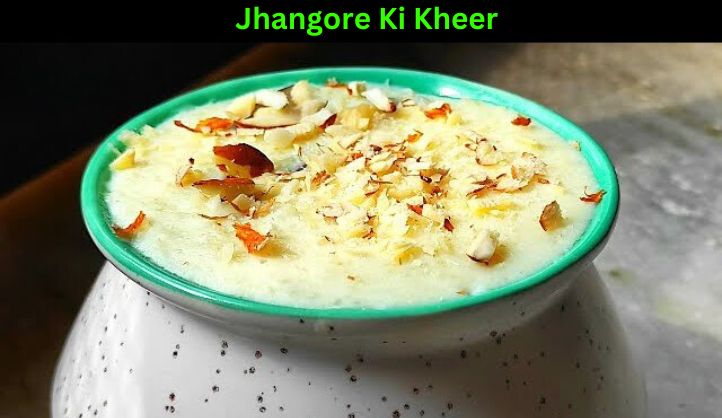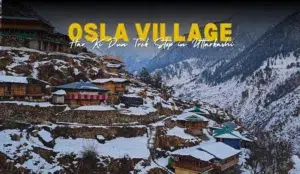Jhangore ki kheer, a traditional dessert from the Himalayan regions of Uttarakhand and Kashmir, is a creamy and flavorful pudding made with jhangora (barnyard millet). This dish is not only delicious but also packed with nutrients, making it a perfect choice for a healthy and satisfying sweet.
A Rich Heritage
Jhangora, a tiny grain with a mild, nutty flavor, has been a staple crop in the Himalayas for centuries. Jhangore ki kheer is a beloved part of the local cuisine, often served during festivals, and celebrations, and even as a comforting breakfast dish. The simplicity of the ingredients and the ease of preparation make it a popular choice for home cooks.
Nutritional Powerhouse
Jhangore ki kheer boasts an impressive nutritional profile. Jhangora itself is a good source of protein, fiber, and essential minerals like iron and calcium. Combined with milk, a rich source of calcium and protein, and nuts and dried fruits, which add healthy fats, vitamins, and minerals, this dessert becomes a powerhouse of nutrients.
Preparing the Perfect Kheer
Making jhangore ki kheer is a straightforward process. The jhangora is first rinsed and soaked, then cooked in simmering milk until it softens and thickens the mixture. Sugar or jaggery is added for sweetness, and nuts and spices like cardamom or kewra essence can be included for an extra layer of flavor. The kheer is typically served chilled, allowing the flavors to meld and the texture to develop a delightful creaminess.
Variations and Tips
Jhangore ki kheer offers endless possibilities for customization. Here are some ideas to explore:
- Sweeteners: Experiment with jaggery, honey, or dates for a natural sweetness.
- Nuts and Fruits: Almonds, pistachios, raisins, and dried figs are popular additions.
- Flavorings: A pinch of cardamom or a few drops of rosewater can add a touch of floral fragrance.
- Vegan Option: Use plant-based milk for a vegan version of this delicious dessert.
Beyond the Dessert Plate
Jhangore ki kheer is more than just a sweet treat. Because of its nutritional value, it can be enjoyed as a light breakfast or a healthy after-school snack. It’s a perfect way to incorporate the goodness of jhangora into your diet.
So, next time you’re looking for a delicious and healthy dessert with a unique twist, give jhangore ki kheer a try. This flavorful pudding from the Himalayas is sure to tantalize your taste buds and nourish your body.
A Symbol of Celebration
Jhangore ki kheer plays a significant role in the festive spirit of the Himalayas. During Makar Sankranti, a harvest festival, it’s a customary offering to the deities. In weddings, it symbolizes sweetness and prosperity for the newlyweds. Its presence across these joyous occasions reflects its importance in the cultural fabric of the region.
Some other dishes of Uttarakhand
Kafuli – The kafuli is a lip-smacking dish is a must-have during the winter. Made with spinach, fenugreek leaves, and radish leaves (sometimes) simmered in a flavorful broth, it’s a powerhouse of greens and perfect for chilly days.
Bhang Ki Chutney – Bhang ki chutney is a unique and flavorful condiment made with cannabis leaves (bhang), coriander, mint, and other spices. It has a pungent aroma and earthy taste, typically served alongside other dishes to add a spicy kick.
Aloo Tamatar Ka Jhol – Aloo ka jhol is a simple yet comforting tomato and potato curry. The local tomatoes in Uttarakhand are known for their intense flavor, making this dish a delightful combination.
Kandali Ka Saag – Kandali ka Saag dish features the local kandali leaves (wild garlic) cooked with tomatoes and spices. It’s a unique and flavorful curry with a strong garlic aroma.
Dubuk – A protein-rich dish made with sprouted pulses (moth dal) cooked in a flavorful gravy. It’s a hearty and nutritious meal, perfect for a filling lunch or dinner.
Chainsoo – Chainsoo is a stir-fried dish made with mandua (finger millet) and seasonal vegetables. It’s a light and healthy option, showcasing the versatility of mandua, a staple grain in the region.
Bal Mithai – No meal is complete without dessert, and Bal Mithai is a popular sweet treat in Uttarakhand. Made with khoya (milk solids) rolled in tiny sugar balls, it offers a delightful burst of sweetness in every bite.
Singodi – Another delicious sweet dish, Singodi are deep-fried dumplings filled with a mixture of nuts and khoya. These sweet treats are perfect for festive occasions or whenever you crave a decadent indulgence.
Regional Variations – A Culinary Journey
While the core ingredients remain jhangora and milk, the magic of jhangore ki kheer lies in its regional variations. Here’s a glimpse into some interesting twists:
- Uttarakhand – Traditionally, ghee is used for a richer flavor, and the kheer is cooked in an open pan, allowing the milk to reduce and develop a thicker consistency.
- Kashmir – Saffron, known as “Kesar,” is often added for a luxurious touch and a vibrant color. Additionally, some recipes incorporate chopped nuts while cooking the jhangora for a more textured bite.
- Himachal Pradesh – Here, you might find variants using jaggery instead of sugar, lending a subtle caramel note to the kheer. Some cooks also add a touch of khoya (reduced milk solids) for an extra layer of richness.
A Step-by-Step Guide to Jhangore Ki Kheer
Ready to try your hand at making jhangora ki kheer? Here’s a basic recipe to get you started:
Ingredients
- 1 cup jhangora (barnyard millet)
- 1.5 liters milk (whole milk for a richer taste)
- ¾ cup sugar (or adjust to your preference)
- ¼ cup chopped nuts (almonds, cashews, pistachios)
- 2 tablespoons raisins
- ½ teaspoon cardamom powder (optional)
- 1 tablespoon ghee
Instructions
- Rinse the jhangora thoroughly and soak it in water for at least 30 minutes.
- In a heavy-bottomed pan, heat the ghee over medium heat.
- Drain the soaked jhangora and add it to the pan. Roast it for a few minutes, stirring constantly, until slightly golden brown.
- Pour the milk into the pan and bring it to a boil. Reduce heat and simmer, stirring occasionally, until the jhangora softens and the milk thickens to a desired consistency.
- Add sugar and continue cooking for another 5-7 minutes.
- Stir in the chopped nuts, raisins, and cardamom powder (if using).
- Turn off the heat and let the kheer cool slightly.
- Garnish with additional nuts and raisins (optional) and serve chilled.
FAQs About Jhangore Ki Kheer
1. What is Jhangore Ki Kheer?
Jhangore ki kheer is a traditional Indian dessert pudding originating from the Himalayan regions of Uttarakhand and Kashmir. Made with jhangora (barnyard millet), milk, and sweetener, it’s known for its creamy texture, nutty flavor, and health benefits.
2. Is Jhangore Ki Kheer Healthy?
Yes, jhangore ki kheer is a healthy dessert option. Jhangora itself is a good source of protein, fiber, and essential minerals. Combined with milk and nuts, it provides a good dose of protein, calcium, healthy fats, and vitamins.
3. What are some variations of Jhangore Ki Kheer?
Jhangore ki kheer has regional variations
- Uttarakhand: Uses ghee for richness and cooks in an open pan for a thicker consistency.
- Kashmir: Often includes saffron for color and flavor, and some recipes add chopped nuts while cooking jhangora for texture.
- Himachal Pradesh: May use jaggery for a caramel note and sometimes khoya for extra richness.
4. Can I make Jhangore Ki Kheer Vegan?
Absolutely! Substitute regular milk with plant-based milk like almond or coconut milk.
5. How can I customize Jhangore Ki Kheer?
Here are some ways to personalize your kheer:
- Sweetener: Experiment with jaggery, honey, or dates for a natural sweetness.
- Nuts and Fruits: Add almonds, pistachios, raisins, dried figs, chopped dates, or apricots.
- Flavorings: Include cardamom powder, a few drops of rosewater, or kewra essence for a floral touch.





